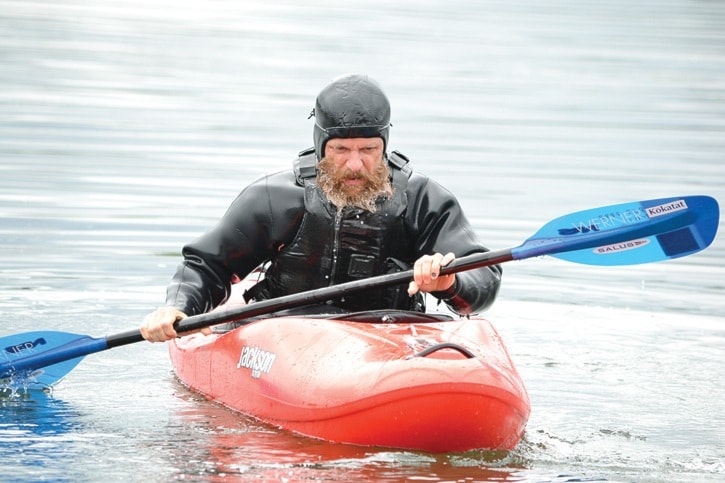Brazilian soccer has its single-named heroes: Ronaldo, Ronaldinho, Cafu, Kaka and the great Pele to name just a few.
And then there’s the great sport of Greenland-style kayaking…what, never heard of it? Well perhaps you know of its sole, single-named legend: Dubside.
That’s right, Dubside. Still confused? Well, here’s an introduction to the man who has more fun rolling in the sea than an otter.
“Hey, how ya doin’,” says the fit and diminutive paddler, with a distinct American east coast accent.
It’s Monday afternoon and Dubside is far from his hometown of Philadelphia, Pennsylvania, where he got into the sport by hand-hauling a fold-up kayak onto buses and trains in order to visit nearby lakes and rivers.
Dubside, 52, doesn’t own a car – probably never will – and eschews modern “conveniences” such as cell phones and hand-held devices, but he’s here in Campbell River at the invitation of Ken Bueckert.
“Dubside, he’s a throwback. He’s not into this high-tech stuff,” says the owner of Kayak Unlimited. “But he is one of the top, if not the top, Greenland rolling instructors in the world.”
Dubside is a four-time Greenland Men’s Rolling Champion which makes him very good, but not the best. That distinction belongs to native-Greenlander Maliqiaq Padilla, the eight-time overall champ, who now resides in Alaska.
“Maliqiaq couldn’t make it this year, hopefully next year,” notes Bueckert, who stands on the beach by the Campbell River estuary.
Out on the water, Dubside is playing around and rolling in a white water kayak belonging to Rob Christensen, 45, of Victoria. He’s been a white water kayaker for 20 years, but after a couple of motor vehicle accidents that resulted in permanent injuries, he’s here to learn new techniques.
“I’m trying to redefine my roll…and I’ve got the roll master to teach me!” Christensen says with a grin. “I’m working up here right now, but I would have driven up just for the lesson.”
Rolling is one of the cornerstones of Greenland kayaking, a sport today, but a way of life for northern hunters for more than a thousand years.
Both Dubside and Bueckert delight in telling the history of how the wives of the hunters would sew animal hide spray skirts around their men as they sat in their kayaks, waiting to head out to the sea.
“If they fell out, they were dead,” Bueckert explains.
Using thin-bladed paddles which offered little wind or water resistance, the hunters chased after whales, seals and walrus. Hunting them took great weaponry and paddling skills, and that’s when the rolling techniques come in handy.
They learned to roll and right themselves quickly in the freezing waters, and sometimes they did this with one hand on the paddle while the other clutched a killing knife in the other.
Today, there’s little need for sustenance hunting, but Greenland-style kayaking lives on as a sport that boasts more than 30 different types of rolls.
“There’s a bunch,” says Allan Dunham of Campbell River, the gold medal roller at last year’s North American Greenland Kayak Competition in Issaquah, Washington.
Dressed in a warm dry suit, Dunham sits in his narrow kayak on the calm estuary to demonstrate the brick roll, the spine roll, the hand roll, the elbow roll, the elbow crook roll, and the plain old standard roll.
“Some of them are useful and some of them (devised) by some guys just playing around,” Dunham explains, back on the beach.
And there’s more to Greenland kayaking than just rolling. The international competitions feature distance racing, harpoon throwing and rope gymnastics, known as Qajaasaarneq.
“Qajaasaarneq is an excercise and training system performed on a double length of horizontally suspended rope,” Dubside explains on his website (www.dubside.net).
“Each exercise consists of a specified position from which you must bring yourself completely around the ropes and return to the starting position. There are a total of 74 different moves, all with Greenlandic names and point values based on the degree of difficulty.”
There are no ropes set up today, just three guys rolling canoes in the mouth of the Campbell River. Bueckert watches with delight and is hopeful more people take up the sport.
“I’m trying to start a kids program here in Campbell River. Hopefuly we’ll have a handful of kids who will start this winter and we have time booked at the indoor pool,” he says.
“There’s a resurgence of interest in this…and it’s not an underground movement. Vancouver Island is the new hotbed of Greenland kayaking.”
E-mail paulr@campbellrivermirror.com
